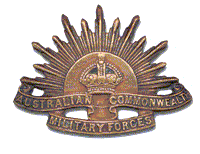Ashtead War Memorials - WWI
Corporal Charles Keith Jago Rooke
Australian Infantry, AIF
| The following poignant account is
of Charles Rooke, whose name appears on
Ashtead’s War Memorial, beside St.
George’s Christian Centre on Barnett Wood
Lane. His relatively brief connection to the district was
severed almost 100 years ago.
Although the memorial entry is cut “Cpt. C.K.J.Rooke”, the “t”, by a slip of the stonemason’s chisel, suggests a posthumous promotion from an actual rank of Corporal. No unit is recorded and, surprisingly, he served with Australian Infantry, Australian Imperial Force (AIF). |
 |
Charles Keith Jago Rooke came from a distinguished family being descended from Captain Frederick William Rooke, Royal Navy, of Lackham House, Wiltshire. He had been born in 1868 as one of the numerous children of Rev. Frederick John Rooke, Rector of Rampisham, Dorset.
According to his page on the Lancing College website, which has a photo of him, he was educated at Mr. Erasmus Wilkinson's School in Bristol and at Lancing College where he was in Heads House from September 1882 to July 1885. He was a member of the Football XI in 1884/5, playing at outside left. After he left school he became Secretary of the Lancing Old Boys football team.
Charles qualified as a Solicitor in 1891 before coming to Ashtead about the turn of the century to live in on Woodfield Lane in one of the newly built villas on the Greville Park Estate. He appears to have commissioned the erection of a new house, The Oaks, on Ashtead Woods Road of which he took possession on 23 March 1905. Evidence of his involvement with the community is provided by (honorary) membership of the Working Men’s Club and, (according to the Ashtead Parish Magazines of 1900/01) pursuing an enthusiasm from his college days, fielding an amateur football team which competed not only with Ashtead Football Club but also a team fielded by Kenneth Maples, another name on the Ashtead War Memorial.
By 1909, he had moved on, with a brother, to settle in Mangalore, Tasmania.
On 4 August 1914, Britain declared war on Germany, recruiting of troops in Australia began within a week, and by 20 August Charles had volunteered for the AIF (the only army on either side which did not resort to conscription throughout WWI). Since the new units were regionally based, he was assigned, during October 1914, with other men from Tasmania to A Company, 12th Infantry, with the rank of Corporal and a Service Number 64.
By the 20th of the same month, that unit had embarked on Transport Ship A2 Geelong at Hobart before sailing to rendezvous with two brigades from New Zealand in Albany Bay, Western Australia, and join a group of 38 transports escorted by warships.
The convoy was diverted from England to Egypt where the force engaged in further training before it was committed to an attempt to seize the Gallipolli Peninsular with the aim of neutralising Turkish defences that controlled the Dardanelles.
Starting on 25 April 1915, Australian soldiers were ferried ashore in lifeboats, each of which held 30 men: casualties were heavy and Corporal Rooke, aged 47, was one of those who lost their lives on the very first day of the landings.
Cpl CKJ ROOKE appears on Panel 64 on Lone Pine Memorial, Gallipolli, which commemorates more than 4900 of ANZAC killed who have no known grave.
The circumstances of his death are unclear but he had got to a beachhead with his men before 7 a.m. when a Captain called for volunteers to act as Scouts: Rooke is reported to have replied “that the whole of his Platoon would volunteer if given five minutes to regain its wind”. He was last seen half an hour later in the vicinity of Walkers Ridge where he was killed and buried 50 yards from the trenches in a grave marked with a stone bearing his name. The body was never recovered.
Throughout 1916, Australian newspapers contained repeated appeals to “Returning Soldiers” for any information about missing men by name, including that of Rooke.
Whilst the authorities had obtained an affidavit on 19 May 1916 from another soldier, who had volunteered with Rooke for scouting duties, he could only say when his comrade had last been seen. The piece of information about what was intended to be CKJ Rooke's interim resting place did not reach his file until 10 August 1921.
CKJ Rooke’s supreme sacrifice is also recorded on a brass plaque in St Giles Parish Church, Ashtead, and by Pontville War Memorial at St Mark’s Anglican Church, Tasmania.
Brian Bouchard
This page is adapted for this website from an article appearing in the Newsletter of the Leatherhead & District History Society, 2009
Links
Soldiers Died in the Great War http://www.researchingww1.co.uk/soldiers-died-in-the-great-war-1914-1919
Commonwealth War Graves Commission www.cwgc.org
Australian War Memorial https://www.awm.gov.au/ww.awm.gov.au
St Mark's Pontville, Tasmania War Memorial: http://thegardensfamily.com/cemeteries/Pontville/WarMemorial/index.htm
He is listed as CK Rooke, seemingly a later addition, below the panel
headed Nurses.
Attestation record: https://recordsearch.naa.gov.au/SearchNRetrieve/Interface/ViewImage.aspx?B=8036603
Note: This states he was born in the Parish of Rumpickham, Dorchester.
He attested on 20 Aug 1914 at the age of 46. After the war his
attestation record noted that an elder brother, who had changed his name
to Trelawny or Trelawney, voluntarily making over war mementoes etc
issuable in respect of CKJ Rooke's services to a younger brother, the
Rev F Darell Rooke, Hovelands, Taunton, Somerset.
The AIF Project https://aif.adfa.edu.au/aif/
Lancing College http://www.hambo.org/lancing/view_man.php?id=189-
If you can add to this page please contact
the editor.
page added 30 Jan 2009, last updated 4 May 15: 28 Nov 17